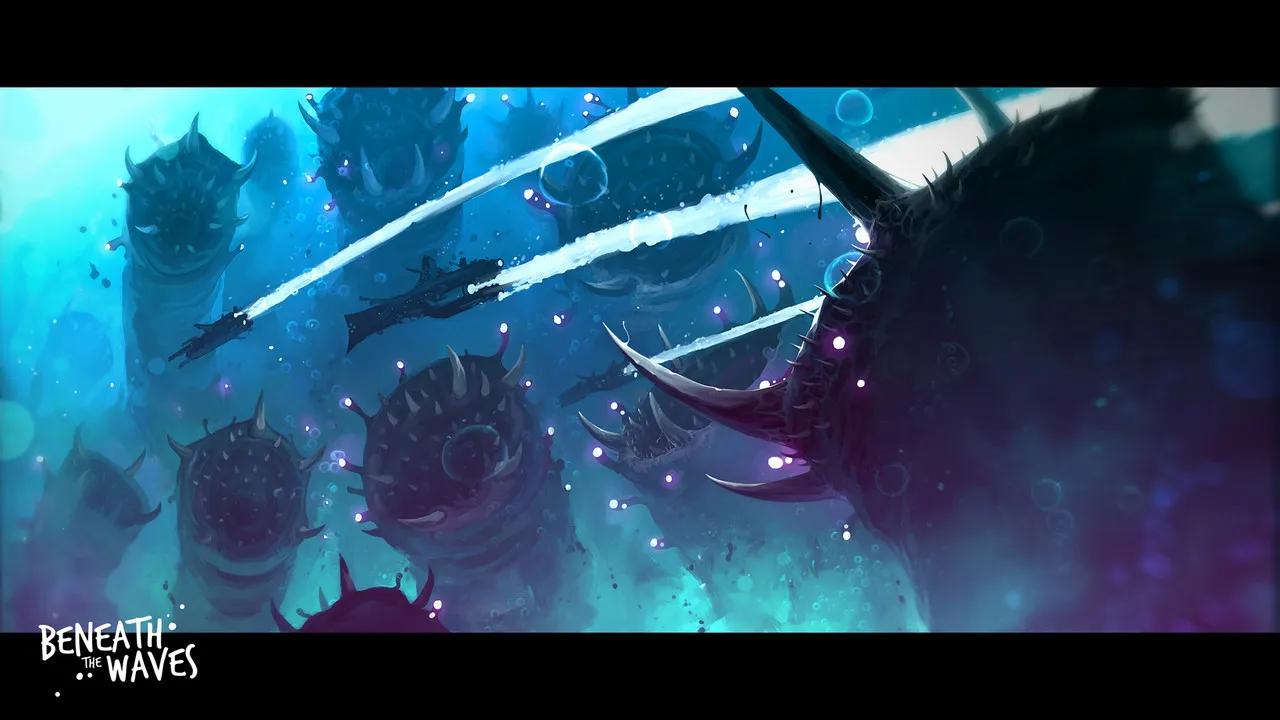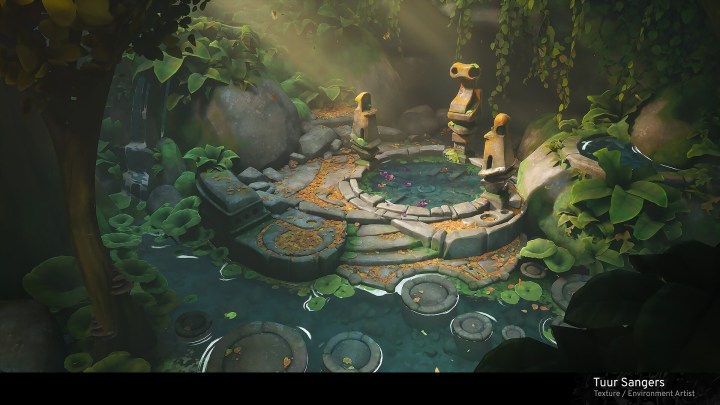Beneath the Waves Challenge: Keyframe Winners Interview
The latest ArtStation Community Challenge, Beneath the Waves, generated tons of really creative work. Challengers for the Keyframe category were given the task of imagining a story that takes place in an aquatic realm and creating 4 keyframes that show the key narrative beats.
Browse all the entries from the Beneath the Waves Keyframe Challenge.
In this interview, the top 3 winners, Lap Pun Cheung, Dominik Mayer and Daria Rashev share their strategies, thought process, obstacles and advice.
 How did you decide what story you were going to tell?
How did you decide what story you were going to tell?
Lap: When I first saw the brief, there were two ways for me to go, scifi or fantasy and I have a preference for scifi. World-building is one of my favourite things to do. As I’ve mentioned in the challenge thread, I was very inspired by the setting of Horizon Zero Dawn, and the documentary Blue Planet 2 as well as making it a loose retelling of Journey to the West. I felt like trying to create an underwater setting I hadn’t seen before with an epic scale to it.
Dominik: I started with a brainstorming and inspiration tour through my Artstation collections. I wanted to do something steampunky like Jules Verne’s Twenty Thousand Leagues Under the Sea. I liked that at this time, there was so much still unknown about the deep sea and what could be hidden down there. So I created my first moodboard and I had two ideas:
- I wanted to do something big. So – Europe right before the First World War. But underwater! Battles in the Depth, terrifying monsters and a dangerous environment! So I created a backstory in which the surface is no longer inhabitable and the nations have to create colonies beneath the waves. With this backsetting I wanted to create a journey of some characters, which can experience all these great and terrifying events.
- My second idea was more an adventurous scientific expedition to an unknown part of the deep sea. I wanted to show an old civilisation and a complex long forgotten species, which are no longer alife but lived there for a long time. The scientists will find some old artifacts and other mysterious structures. During the story they would have revived some old functions of the city, or mayba even a member of their species.
Daria: At first, it was quite complicated for me to understand what I was going to do with this theme. Usually I try to see something like a movie in my head and translate it into some first initial sketches. I’m not quite sure how I ended with this particular story about creatures from the deep – this idea looks pretty straight-forward but it wasn’t straight-forward for me, for sure. I felt like I was talking to myself through those sketches, which was an interesting experience. It seemed I wasn’t really interested in any story about underwater city or fantasy creatures etc. but then I recalled a “Point Nemo” concept, the oceanic pole of inaccessibility, the place in the ocean that is farthest from any land. This concept gave me chills and I decided exploring this could be really interesting.
 What was the most challenging part for you?
What was the most challenging part for you?
Lap: The most challenging part for me was to create a coherent world on which to layer the story. A lot of the hard work was done before I’d even drawn anything since it had to be worked out in my head and on paper in a way that made some sense.
Dominik: At first I had to decide which of my two ideas I should go for. It was really hard and so I started asking the community. After one week, there were the same amount of votes for both ideas! So I picked the one I found slightly more interesting but the hardest challenge was still there to come. I had a lot of ideas and I wanted to show them all. So the most difficult thing for me was to nail it down to four single keyframes. I wanted to show a beginning with a problem that needs to be solved, a climax and at the end a solution of the problem.
After a lot of thinking, I came up with my story about a journey of a couple of submarines to a far away outpost. I created a constantly increasing danger on their way. The first danger was that they have to deal with other humans, the second one was to fight the monsters of the depth and the last and biggest danger was to face the unbeatable force of nature itself deep down in a very hostile environment. So that has to be shown in the first three images. And then I had one left for the solution.
Daria: Probably inventing the story itself. I felt I couldn’t create anything original for this theme. It didn’t spark anything specific in me at the very first glance. In the moments like that the best strategy is to start do anything no matter what and see how it will end. So Istarted from “Oh come on, this is dump idea” and ended up with a solid story in my head. I even faced problems to pick only four moments from! Plus, for each of those moments, I made too much sketches. Here, I want to give my thanks to the community and their feedback. They helped me a lot to pick a proper sketch for finalization. Finalization wasn’t too easy for me too. I can say i’m satisfied only with half of my final keyframes – i wish i could make them better, especially the one with a girl and the wave – sketches was much more dramatic than a final shot. But anyway, it was a huge fun and i feel like i succeed in showing my idea. But i hope i gave the spectator some room for imagination as well.
Were there any other submissions that you were following or stood out to you?
Dominik: Of course! I followed a lot of them. It’s amazing to see how many different interpretations and ideas were out there.I was mainly looking at the keyframe submissions. I really liked Michael Topol and Xd Xu‘s colors, the great scenes of Diane Özdamar and Jason Boesch and of course the submissions of the other winners and honorable mentions! But the list is too long and this doesn’t even cover the other 2D challenges and the production phase submissions.
 As a first time challenger or returner, what was your strategy coming into the challenge?
As a first time challenger or returner, what was your strategy coming into the challenge?
Lap: like to take part in as many ArtStation challenges as I can, time permitted. I really enjoy them. I didn’t have any specific strategy for this one. I definitely aim to win whenever I enter a competition but top priority is usually to have fun and create an interesting story for myself and if other people enjoy it too, it’s a big bonus for me.
Dominik: It was my first Artstation Challenge and I didn’t have any real strategy. I was hoping to have some fun with this amazing topic and was very excited to see how it will go.
Daria: I’ve participated in all ArtStation challenges but this was my very first time in a keyframe category. I believe the light and composition are the most powerful things in cinematic illustrations and I tried to push them as far as I could. I spent one day just gathering some interesting references and it was really helpful. For my compositions i’ve tried to make them very simple yet effective. I broke them down to the basic geometric shapes and then started to add details and plot. I used 3D block outs to speed up my process and bring some photo-realistic details without spending too much time on it, which is always a good thing for production process (and for lazy me).
Any tips for future challengers?
Lap: My tips for future challengers is to keep a good eye on timeframe, write up a story and do some world-building before you draw anything. It can help keep your pieces in line with each other. Most important of all to me is to have fun with it because otherwise it becomes very easy to quit before you finish.
Dominik: If you like the topic of a future challenge, just join and play around! Don’t think too much about the competition, the community is great and it is really nice to give and get feedback. It is hard work, but try to finish it in time. It is worth it, I learnt a lot. If you have fun while you are working on it, it will get better and better and at the end you will get attention for your work and some really nice portfolio pieces!
Daria: Have fun! Seriously, ArtStation challenges aren’t only a good possibility to expose yourself and learn something new, but a really good and crazy ride on a roller coaster of creativity. I love them for their intensity – you just have no time for hanging around, you need to go straight into the battle. And as part of the “battle”, I understand the process of learning and making yourself a better artist. I believe you shouldn’t wrestle with anyone but yourself. For me, the best strategy to win this battle is to make the process itself more valuable than any possible prize.






















